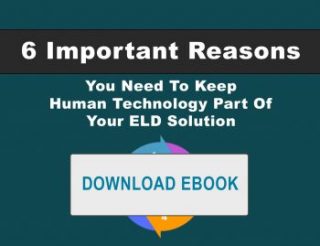How Will ELDs Affect Roadside Inspections? A DOT Inspector Perspective
AOBRDs and other e-log devices have been around for a while now. Much has been said about the mandatory adoption of ELDs from the company and drivers perspective. But, what about the DOT inspector? How will they approach an ELD hours of service roadside audit?
Inspectors Face A Learning Curve Too!
Everyone agrees that there will not only be a learning curve for the carrier but for the enforcement side as well. Top management within law enforcement circles often site a more global view of hours of service enforcement and the ELD mandate. They see the ELD technology as getting more accurate HOS data but not really changing the roadside inspection process.
In talking with the roadside inspectors themselves, a little different perspective is shared.
A big difference between the driver and the roadside inspectors ELD learning curve is that inspectors will face many different types of ELDs/AOBRDs platforms. Different software platforms and different devices, with each accessed in a different manner will hamper an inspectors attempt to help access the required information.
As a result, inspectors will simply have to rely upon the driver to produce the required information out of their brand of device. In other words, there is a greater potential for less tolerance when it comes to a driver not understanding how his/her ELD works.
There are data transfer requirements in place to help streamline log information being sent from the driver to the inspector. However, if the data transfer fails to work during roadside inspections for any reason, an ELD’s display screen will remain a valid way to audit the driver’s logbook data. Inspectors may gravitate towards using the display screen for audits simply because it most closely resembles the common format they are familiar with.
We have heard from inspectors who, when faced with an ELD at roadside, resort to a spot check process vs a full audit. They may pull scale crossing or other data, write down times and dates, and match them with driver log records in a spot check fashion. If the data is close, you should be good to go. If the data is off, inspectors may have drivers email logs to them and move on to the mechanical inspection. By the time the mechanical inspection is done, the inspector should have received the driver logs data and can continue with an in depth log inspection.
Inspectors Will Rely On The Drivers To Know How Their ELD Operates
Like drivers, there are many inspectors who just want to do things “the old way” and this transition will be difficult. These inspectors will especially rely on the drivers to know how to pull up required log book information. Drivers who can quickly and easily provide the data will be quickly on their way. Those that stumble or simply can’t provide the information will likely incur a serious HOS violation.
Don’t be caught off guard at an inspection and take the chance of incurring needless hours of service violations simply because your drivers don’t understand how your device works. The best advice is to devise a driver training process that works. Require all drivers to attend and then repeat the training until each and every driver knows it backwards and forwards. Doing so will help ensure an HOS inspection is a clean inspection.
Drivers, do not rely on inspectors to know your ELD device. Drivers MUST be trained!
Glostone Can Incorporate And Simplify The Compliance Burdens By Managing:
- Help manage your ELD solution
- Driver qualification (DQ) files
- Drug and alcohol testing
- Fuel and mileage taxes
- Driver and management training
- Vehicle registration, licenses, and permits
- Create and implement Corrective Action Plans when you do face hefty fines
- and even more


